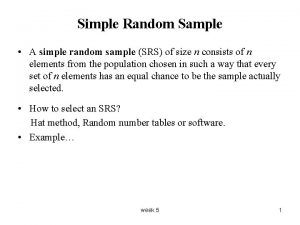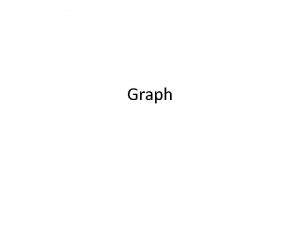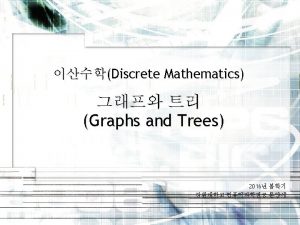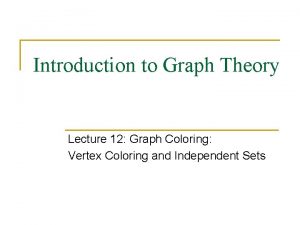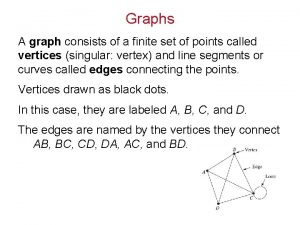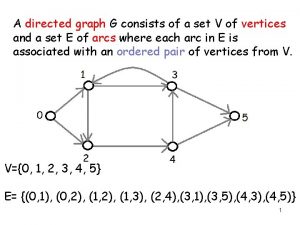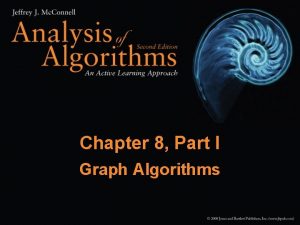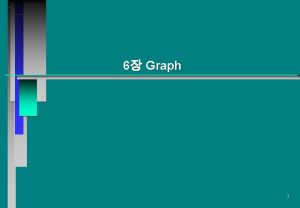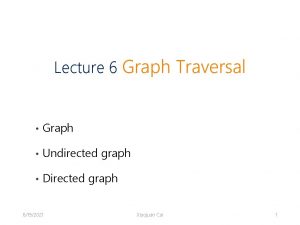Graph Terminology A graph consists of a set






















- Slides: 22


Graph Terminology A graph consists of a set of vertices V, along with a set of edges E that connect pairs of vertices. An edge e = (vi, vj) connects vertices vi and vj. A self-loop is an edge that connects a vertex to itself. We assume that none of our graphs have self-loops. Vertices = {v 1, v 2, v 3, …, vm} Edges = {e 1, e 2, e 3, …, en}

Graph Terminology (continued) The degree of a vertex is the number of edges originating at the vertex. Two vertices in a graph are adjacent (neighbors) if there is an edge connecting the vertices. A path between vertices v and w is a series of edges leading from v to w. The path length is the number of edges in the path.

Graph Terminology (continued) A graph described until now is termed an undirected graph. Movement between vertices can occur in either direction. In a digraph, edges have a direction. There might be an edge from v to w but no edge from w to v.

Graph Terminology (continued)

Graph Terminology (continued) In a digraph, a directed path (path) connecting vertices vs and ve is a sequence of directed edges that begin at vs and end at ve. The number of the edges that emanate from a vertex v is called the out-degree of the vertex. The number of the edges that terminate in vertex v is the in-degree of the vertex.

Adjacency Matrix An m by m matrix, called an adjacency matrix, identifies the edges. An entry in row i and column j corresponds to the edge e = (v, , vj). Its value is the weight of the edge, or -1 if the edge does not exist. 7 Main Index Contents © 2005 Pearson Education, Inc. , Upper Saddle River, NJ. All rights reserved.

Adjacency List 8 Main Index Contents

Graph Traversal Algorithms In general, graphs do not have a vertex, like a root, that initiates unique paths to each of the vertices. From any starting vertex in a graph, it might not be possible to search all of the vertices. A graph could have a cycle that results in multiple visits to a vertex.

2 Major Traversal Algorithms 1. 2. Breadth-first search visits vertices in the order of their path length from a starting vertex. It may not visit every vertex of the graph Depth-first search traverses all the vertices of a graph by making a series of recursive calls that follow paths through the graph.

Processing the Traversal To simplify the search graph algorithms discern the state of a vertex during the algorithm by using the colors WHITE, GRAY, and BLACK.

Breadth-First Traversal 1. 2. 3. Process and mark the starting vertex and place it in a queue Remove a vertex (v) from the front of the queue For each unmarked neighbor (u) of v: a. b. Process u, mark u, and place u in the queue. GOTO 2 (Recursive visit of unmarked neigbors!).

Example: Breadth-First Traversal Vertices are visited in the order A, B, C, G, D, E, F

Breadth-First Traversal (continued) Color all vertices of the sample graph WHITE and push the starting vertex (A) onto the queue visit. Queue. Pop A from the queue, color it BLACK, and insert it into visit. List, which is the list of visited vertices. Push all WHITE neighbors onto the queue.

Breadth-First Traversal (continued) Pop B from the queue and place it in visit. List with color BLACK. The only adjacent vertex for B is D, which is still colored WHITE. Color D GRAY and add it to the queue

Breadth-First Traversal (continued) Pop C and place it in visit. List. The adjacent vertex G is GRAY. No new vertices enter the queue.

Breadth-First Traversal (continued) Pop vertex G from the queue and place it in visit. List. G has no adjacent vertices, so pop D from the queue. The neighbors, E and F, enter the queue.

Breadth-First Traversal (continued) Continue in this fashion until the queue is empty.

Depth-First Traversal The depth-first visit algorithm moves along a directed edge to one of the start vertex’s neghbors It moves from here to other directed edges until the end of a path (a terminal vertex is a vertex that has no neighbours or only neighbours that are BLACK). At the terminal it backs up to parent vertex to find whether the parent has any more unmarked neighbors, if so continue searching.

Depth-First Traversal (continued) Color all vertices WHITE. A vertex is colored GRAY when it is first contacted in a recursive descent. It becomes BLACK only when the vertex is actually visited. Begin at a starting vertex and search down paths of neighbors until reaching a vertex that has no neighbors or only neighbors that are BLACK. At this point, a visit occurs at the "terminal" vertex and it becomes BLACK.

Depth-First Traversal (continued) Backtrack to the previous recursive step and look for another adjacent vertex and launch a scan down its paths. There is no ordering among vertices in an adjacency list, so the paths and hence the order of visits to vertices can vary.

Depth-First Traversal (continued) Discover A (color GRAY) Discover B (color GRAY) Discover D (color GRAY) Discover E (color GRAY, then BLACK) Backtrack D (color BLACK) Backtrack B (color BLACK) Backtrack A (A remains GRAY) Discover C (color BLACK) Backtrack A (color BLACK). Visit complete.
 Total set awareness set consideration set
Total set awareness set consideration set Training set validation set test set
Training set validation set test set Simple random sampling formula
Simple random sampling formula Set terminology
Set terminology Graph terminology
Graph terminology Graph consists of a
Graph consists of a Bounded set vs centered set
Bounded set vs centered set Fuzzy logic
Fuzzy logic Crisp set vs fuzzy set
Crisp set vs fuzzy set Crisp set vs fuzzy set
Crisp set vs fuzzy set What is the overlap of data set 1 and data set 2?
What is the overlap of data set 1 and data set 2? The function from set a to set b is
The function from set a to set b is Chart terminology
Chart terminology Ectomy medical term
Ectomy medical term Bow tie structure web graph
Bow tie structure web graph Line graph terminology
Line graph terminology Graph terminology
Graph terminology Maximum size of independent set is
Maximum size of independent set is What is an independent set in a graph
What is an independent set in a graph Graph set up
Graph set up Bridge graph
Bridge graph Resource allocation graph and wait for graph
Resource allocation graph and wait for graph Define work energy theorem
Define work energy theorem


